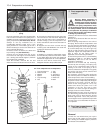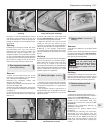
3 With the engine stopped, slowly move the
steering from lock-to-lock several times to
purge out the trapped air, then top-up the
level in the fluid reservoir. Repeat this
procedure until the fluid level in the reservoir
does not drop any further.
4 Start the engine, then slowly move the
steering from lock-to-lock several times to
purge out any remaining air in the system.
Repeat this procedure until bubbles cease to
appear in the fluid reservoir.
5 If, when turning the steering, an abnormal
noise is heard from the fluid lines, it indicates
that there is still air in the system. Check this
by turning the wheels to the straight-ahead
position and switching off the engine. If the
fluid level in the reservoir rises, then air is
present in the system, and further bleeding is
necessary.
6 Once all traces of air have been removed
from the power steering hydraulic system,
turn the engine off and allow the system to
cool. Once cool, check that the fluid level is
up to the maximum mark on the power
steering fluid reservoir, topping-up if
necessary.
18 Power steering pump -
removal and refitting
3
Removal
1 Remove the alternator as described in
Chapter 5A.
2 Prepare a suitable container, then
disconnect the fluid hoses from the pump,
and allow the fluid to drain into the container.
3 Unscrew and remove the power steering
pump mounting bolts, then withdraw the
pump.
Refitting
4 Refitting is a reversal of removal, but on
completion, tension the drivebelt as described
in Chapter 1, and bleed the power steering
hydraulic system as described in Section 17.
19 Track rod end - removal and
refitting
3
Removal
1 Chock the rear wheels then jack up the
front of the car and support it on axle stands
(see “Jacking and vehicle support”). Remove
the relevant front roadwheel.
2 Loosen the locknut on the track rod end by
a quarter of a turn.
3 Unscrew the balljoint locknut and use an
extractor tool to separate the balljoint tapered
shank from the hub carrier steering arm (see
illustration).
4 Unscrew the track rod end from the track
rod, noting the number of turns necessary to
remove it. Remove the locknut from the track
rod end threads.
Refitting
5 Screw on the locknut then screw the new
track rod end the same number of turns onto
the track rod.
6 Clean the taper surfaces then fit the
balljoint shank to the hub carrier steering arm
and tighten the nut to the specified torque.
7 Tighten the locknut on the track rod end.
8 Refit the roadwheel and lower the car to the
ground.
9 On completion, have the front wheel toe
setting checked (see Section 21).
20 Track rod - removal and
refitting
4
Removal
Note: A new inner balljoint lockwasher must
be used on refitting.
1 Remove the track rod end as described in
Section 19.
2 Release the retaining clips and slide the
rubber bellows off the end of the steering gear
housing and track rod (see illustration).
3 Unscrew the track rod inner balljoint from
the steering rack end, preventing the steering
rack from turning by holding the balljoint
lockwasher with a pair of grips. Take great
care not to mark the surfaces of the rack and
balljoint.
4 Remove the track rod assembly, and
discard the lockwasher - a new one must be
used on refitting.
5 Examine the track rod inner balljoint for
signs of slackness or tight spots, and check
that the track rod itself is straight and free from
damage. If necessary, renew the track rod.
Refitting
6 Locate the new lockwasher assembly on
the end of the steering rack, and apply a few
drops of locking fluid to the track rod inner
balljoint threads.
7 Screw the balljoint into the steering rack,
and tighten it to the specified torque whilst
retaining the lockwasher with a pair of grips.
Again, take great care not to damage or mark
the track rod balljoint or steering rack.
8 Carefully slide on the rubber bellows, and
locate it on the steering gear housing. Turn
the steering fully from lock-to-lock, to check
that the gaiter is correctly positioned on the
track rod, then secure it in position with new
retaining clips.
9 Refit the track rod end as described in
Section 19.
10•10 Suspension and steering
19.3 Separating the track rod end from the
hub carrier steering arm
1 Bellows
2 Lock washer
3 Track rod
4 Locknut
5 Track rod end
20.2 Track rod components
If difficulty is experienced in
loosening or tightening a
balljoint taper pin nut due to
the taper pin turning in the
eye, apply pressure with a jack or long
lever to the balljoint socket to force the
taper pin into its conical seat.


















